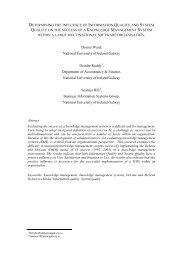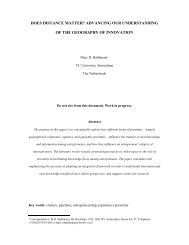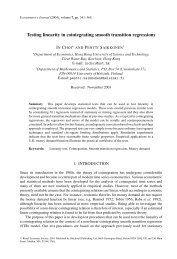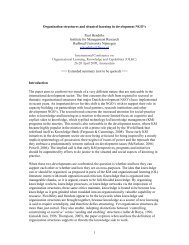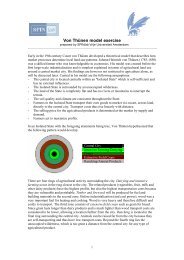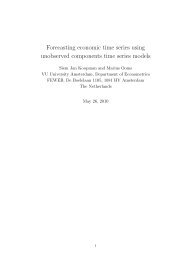The effects of road pricing - Feweb - Vrije Universiteit Amsterdam
The effects of road pricing - Feweb - Vrije Universiteit Amsterdam
The effects of road pricing - Feweb - Vrije Universiteit Amsterdam
Create successful ePaper yourself
Turn your PDF publications into a flip-book with our unique Google optimized e-Paper software.
It should not be forgotten that it remains a political issue to decide what allocation <strong>of</strong><br />
<strong>road</strong> <strong>pricing</strong> revenues is equitable. Political acceptability will reflect popular<br />
perceptions and the distribution <strong>of</strong> political power. When policy makers are not<br />
satisfied with the situation, the implementation <strong>of</strong> individual specific transfers can<br />
satisfy the distributional goals. If this redistribution can be realised without distorting<br />
the market mechanism, equity and efficiency can both be reached. <strong>The</strong> proper<br />
instrument for carrying out such transfers is a lump-sum tax, i.e. a tax that does not<br />
depend on any action <strong>of</strong> the individual: there is no way that he can change the tax<br />
liability (Atkinson and Stiglitz, 1980). A lump-sum tax would be one that induces<br />
income <strong>effects</strong> alone, no substitution <strong>effects</strong>. If such lump-sum transfers were possible<br />
there would be no reason to worry about distributional concerns in the transportation<br />
<strong>pricing</strong> policy domain. Unfortunately, in practice, it is almost impossible to effect<br />
transfers without distorting the market mechanism.<br />
It appeared from the previous discussion that both the consumers’ surplus and the<br />
social surplus weight monetary gains and costs equally for all individuals. <strong>The</strong> fact<br />
that these objective functions are so <strong>of</strong>ten used in transportation policy analysis does<br />
not imply that researchers deliberately want to ignore distributional issues. <strong>The</strong> main<br />
reason for using social surplus as the welfare measure is that it is easier to use, mainly<br />
because it requires only information at the market level.<br />
Sometimes the term ‘first-best’ optimum is reserved for situations in which lump-sum<br />
taxes can be used to address distributional issues. In such circumstances, the marginal<br />
social value <strong>of</strong> the public good is, in the optimum, equal to the welfare weight <strong>of</strong> each<br />
traveller. In such a first-best optimum, prices are equal to marginal costs. This does<br />
not mean that there is no reason for government intervention because <strong>of</strong> the existence<br />
<strong>of</strong> externalities. Charges including the marginal external costs have to be introduced<br />
in order to guarantee that the travellers pay the full marginal cost associated with their<br />
actions.<br />
This links to the ‘user pays’ concept, which states that all users <strong>of</strong> transport<br />
infrastructure should pay for the costs, including environmental and other external<br />
impacts. Protection <strong>of</strong> the environment has become an important objective for<br />
governments in recent years, and the ‘polluter pays’ principle is <strong>of</strong>ten proposed to<br />
reduce and control environmental pollution in a fair way. Marginal cost-based <strong>pricing</strong><br />
can be regarded as being fully consistent with the user pays principle under first-best<br />
circumstances. However, all dimensions <strong>of</strong> travel behaviour must be priced at<br />
marginal social cost, and distortions elsewhere in the economy must be absent in a<br />
first-best optimum.<br />
Under this interpretation, the ‘user pays principle’ implies that each user fully pays for<br />
the cost he imposes. But the principle can also be interpreted to mean that users<br />
together should cover the costs they collectively impose, implying average cost<br />
<strong>pricing</strong>, rather than marginal cost <strong>pricing</strong>. <strong>The</strong>se two concepts are mutually<br />
inconsistent, unless marginal cost <strong>pricing</strong> just suffices to cover costs.<br />
2.4 Deviations from first-best <strong>pricing</strong><br />
2.4.1 Deviations from marginal cost <strong>pricing</strong><br />
<strong>The</strong> previous section has shown us that equality <strong>of</strong> prices and marginal costs leads to<br />
an efficient use <strong>of</strong> resources in an otherwise ideal world. But the practical world is not<br />
ideal. Actual (market) prices may deviate from marginal costs for a number <strong>of</strong><br />
reasons. Moreover, given the existence <strong>of</strong> such distortions, it is usually not optimal to<br />
16





